How to Make Black Limes
Black limes are Persian dehydrated or dried limes packed with intense citrus flavour. Use them to liven up soups, stews and sauces. They are simple to make at home and can keep for months in the pantry!
Like so many home cooks and cookbook lovers, I was first introduced to black limes by Yotam Ottolenghi and Ixta Belfrage in their iconic cookbook, Flavour. Immediately enamoured of Noor Murad’s Black Lime Tofu recipe – and unable to find black limes in Cape Town – I set out to make black limes at home.
I am happy to report that the process is as straightforward as it is rewarding. Sure, it takes some time and – depending on the weather – you may need to leave the oven on low for extended periods. But that can easily be justified when you make a large batch of these little flavour bombs.
They keep for months in the pantry. And the most incredible citrusy smell will permeate your home when the limes are drying in the oven.
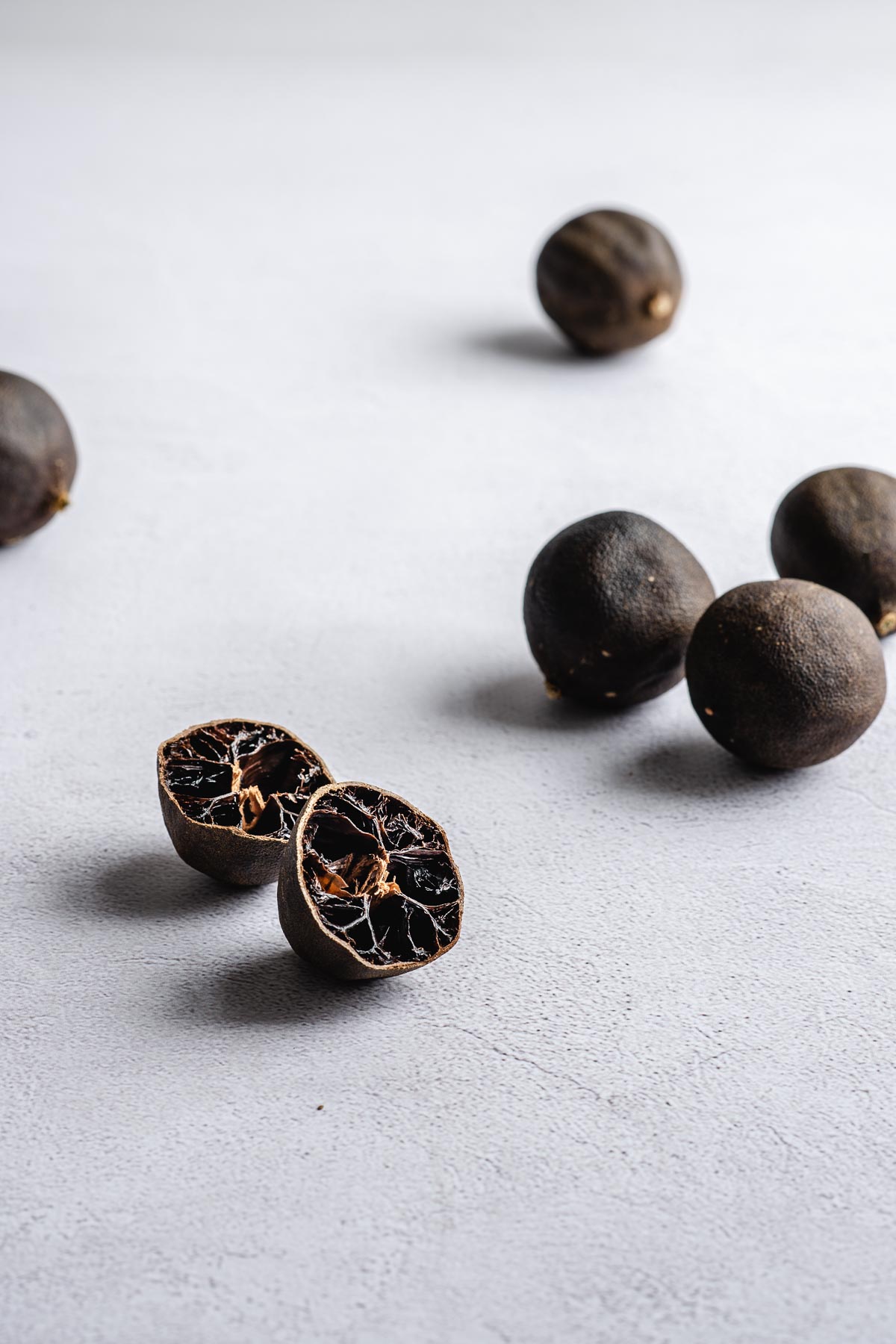
What are black limes?
Black limes, or dried limes, are common across the Middle East. They are also called noomi basra (Iraq), limoo amani (Iran) and loomi (Oman). Blanched and then dried in the sun, an oven or a dehydrator, these dark brown – almost black – limes deliver supercharged citrus flavour to any stew or soup.
How to make black dried limes
The process is super simple – just follow this black lime recipe for step-by-step instructions.
- Step 1: Get some fresh Persian limes.
- Step 2: Blanch the fresh limes, i.e. briefly boil in salted water.
- Step 3: Plunge in an ice bath to stop the cooking process.
- Step 4: Dry until the limes are rock hard and dark brown to black.
Start with fresh Persian limes
Black limes are Persian, so it makes sense that fresh Persian limes are the traditional choice. A quick inquiry to my local supermarket confirmed that the seedless limes I’ve been buying for years are Tahiti limes (a cultivar of Persian limes).
If you are unsure of the lime cultivar you buy, ask your grocer for more information. But I am sure that any lime with thin enough skin can be turned into a mouth-puckering little flavour bomb when dried out. I’ve even made black kumquats using this method. Let me know if you also try this method with a citrus fruit other than Persian limes!
Select limes that are unbruised, though some blemishes are acceptable. I prefer seedless limes. However, if your limes have seeds, simply remove the seeds before grinding the black limes into a powder. And take care that the seeds don’t escape in your soup or stew when using the black limes whole.
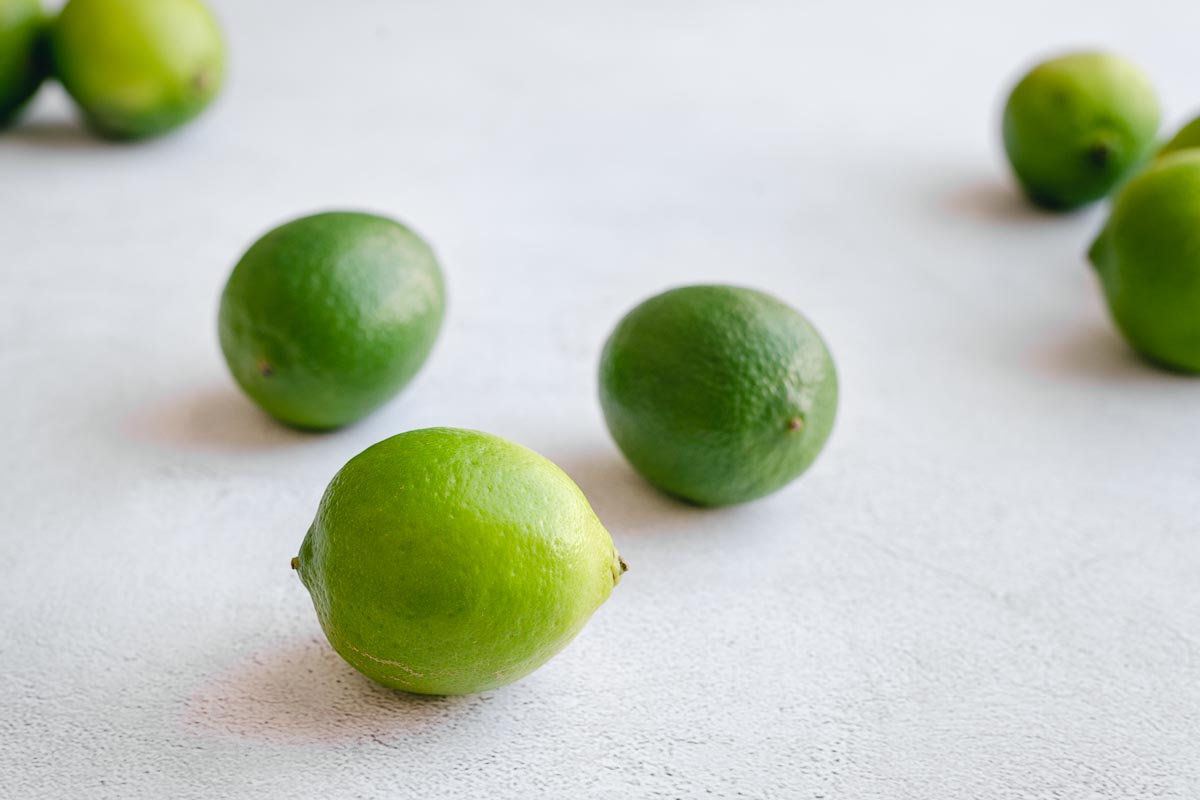
Briefly boil in salted water
First, get your ice bath ready. Use a bowl large enough to hold all the limes. Place ice blocks in the bowl and top with room temperature or cold water. Let it stand for a minute or so until the water is ice cold.
Fill a pot with enough water to cover the limes, place the water (without the limes) on high heat and bring to a rolling boil. Some sources say to salt the water, others don’t. I dried two batches of limes at the same time, one salted and one unsalted. It did not make any apparent difference to the drying time, nor did it noticeably impact the final taste. But it could be the invisible antibacterial properties of salt that are at play here, so I add 1 teaspoon of salt per 1 litre of water to be safe.
Once the water is boiling and your ice bath is ready, add the limes to the boiling water for 60 to 90 seconds. Do not exceed 90 seconds.
Immediately chill to stop the cooking process
Remove the limes with a slotted spoon. Drop them straight from the boiling water into the ice bath and leave them to cool down for a few minutes to stop the cooking process.
Dry the cooled limes with a clean tea towel. If your shop-bought limes have a wax coating, it should melt off and stay behind in the pot with the hot brine. But I like to give the blanched limes a good rub with the tea towel to get off any residue.
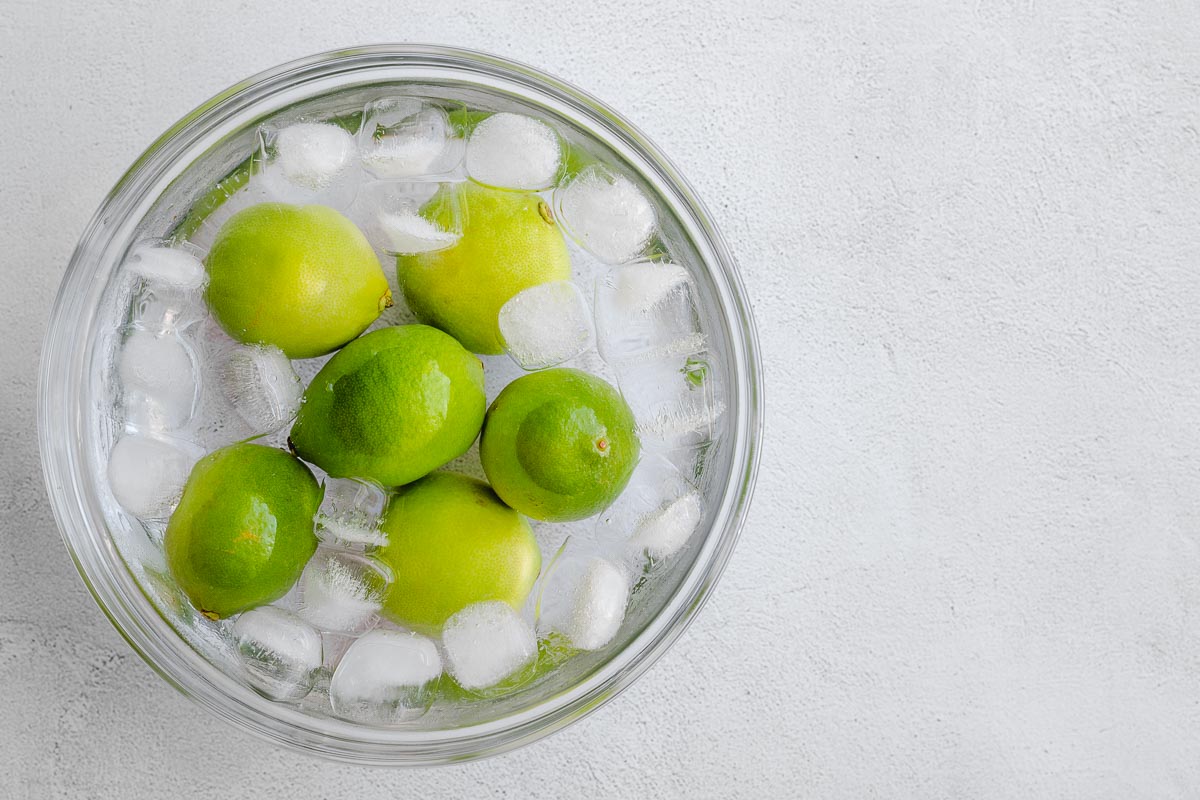
Dry the limes
You can dry the limes in the sun if the weather allows. But I live close to the coast. While the humidity does not reach uncomfortable tropical levels, temperatures are too moderate and the air too humid – and me too impatient – to dry the limes in the sun. So I opt for a combination of sun and oven drying.
Place the limes on a cookie cooling rack in full sun. Move the rack throughout the day to find sunny spots and rotate the limes from time to time. At night, bring the limes inside and place in the oven at 158 °F (70 °C) or use the residual oven heat after dinner.
You can also choose to dry the limes in the oven only. Place the limes directly on the bars of the oven rack to allow air circulation and set the oven to a very low temperature, around 158 °F (70 °C).
Whenever I go to bed or leave the house, I turn the oven off.
Rotate the limes every few hours to allow for even drying. The process can take anywhere from 2 to 5 days – depending on your choice of drying method. You know they are ready when they are dark in colour, light in weight and rock hard.
Store the black limes in a sealed container in a dark cupboard. It will last for months.
How to make black lime powder
Place the dried limes on a cutting board and bash with a heavy object, like a skillet. Place the black dried lime pieces in a spice grinder – or a mortar and pestle if you have the patience and the arm strength – and grind until fine.
The limes I use are seedless. But if you see any seeds after bashing the lime, remove them before grinding. Store the powder in a sealed container to preserve freshness.
The black lime powder requires less storage space compared to the whole limes, so I like to have a bit of both. Dried lime seasoning is an excellent addition to any salad, stew or grain that requires an acidic kick. Or sprinkle on a boiled egg with some salt flakes.
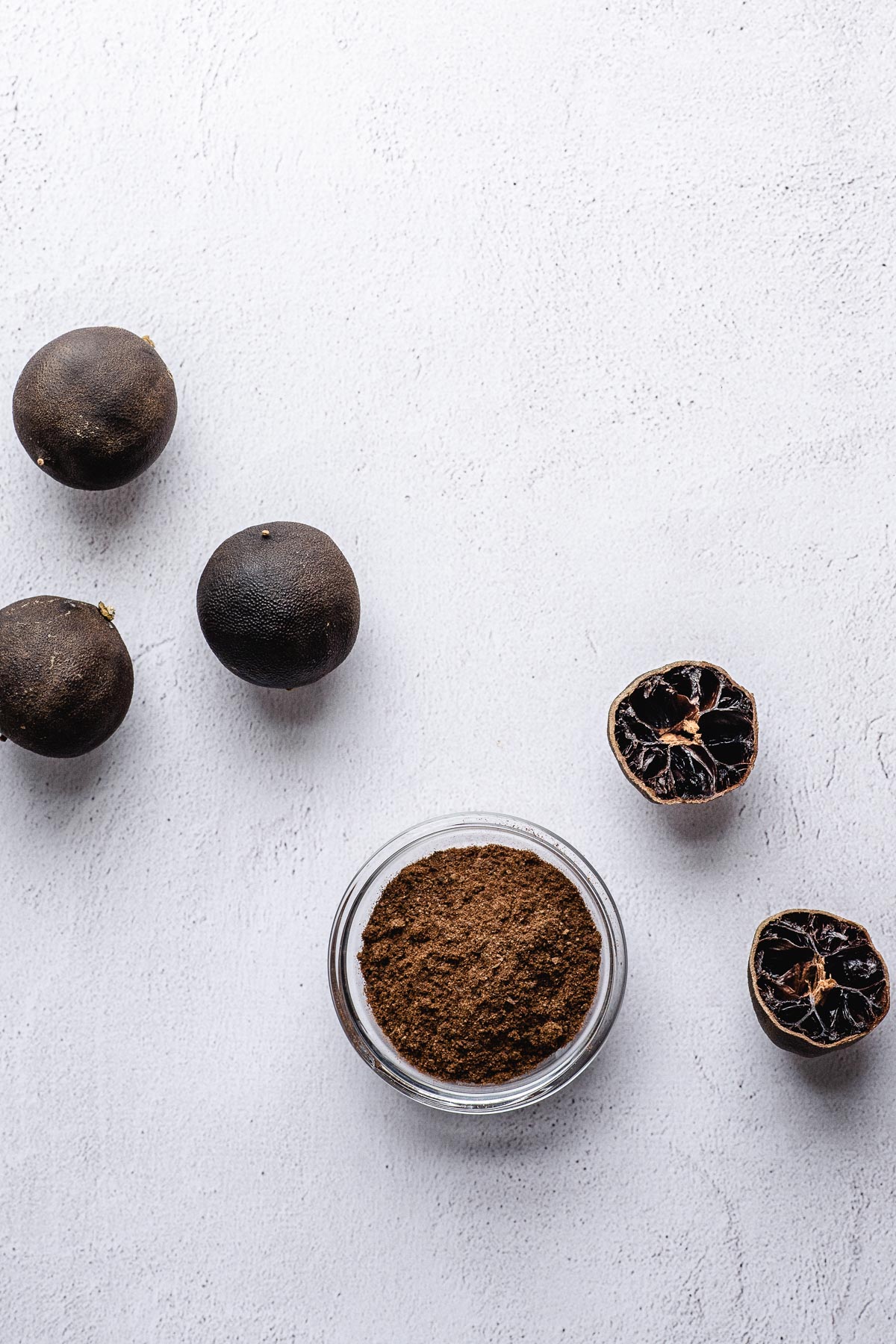
How to use black dried limes
Black limes are acidic and have a concentrated lime juice and zest flavour. Use ground black lime like you would sumac, or add the whole black limes to soups and stews.
Traditionally black limes are pierced before being added to soups and stews. However, I dry the limes until rock hard which makes them difficult – and dangerous – to pierce. To soften, soak the dried limes in boiling water while you prepare your ingredients. Add the soaking liquid to your stew or use it for cooking rice.
Use dried black lime powder to make citrus finishing salt by mixing four tablespoons of flaked sea salt with a half teaspoon of black lime powder. Store the finishing salt in a small jar and sprinkle it liberally over salads, soups and stews.
Why not try something more adventurous too? A black lime salt rim on a Margarita, anyone?
Still not convinced? Read why Yotam Ottolenghi believes we should all be cooking with black limes more.
Or try these black lime recipe ideas:
- Make black lime onions to use as a salad topping, like this Tomato & Pomegranate Salad.
- Pierce or half a black lime and add it to soups and stews in need of acidity. Once pierced, it needs about an hour to simmer for it to release enough limy goodness. That’s why I sometimes cheat by cutting my lime in half to deliver supercharged flavour faster. Just remove the seeds if you see any. Try this Persian-Inspired Aubergine & Black Lime Stew.
- Black lime yoghurt as a salad dressing is perfect with a veggie-forward salad, like this Artichoke & Goat Cheese Salad.
- Try some quick pan-fried black lime and chilli croutons to add magic to any salad.
Black limes are the secret weapon your pantry needs. Try it!
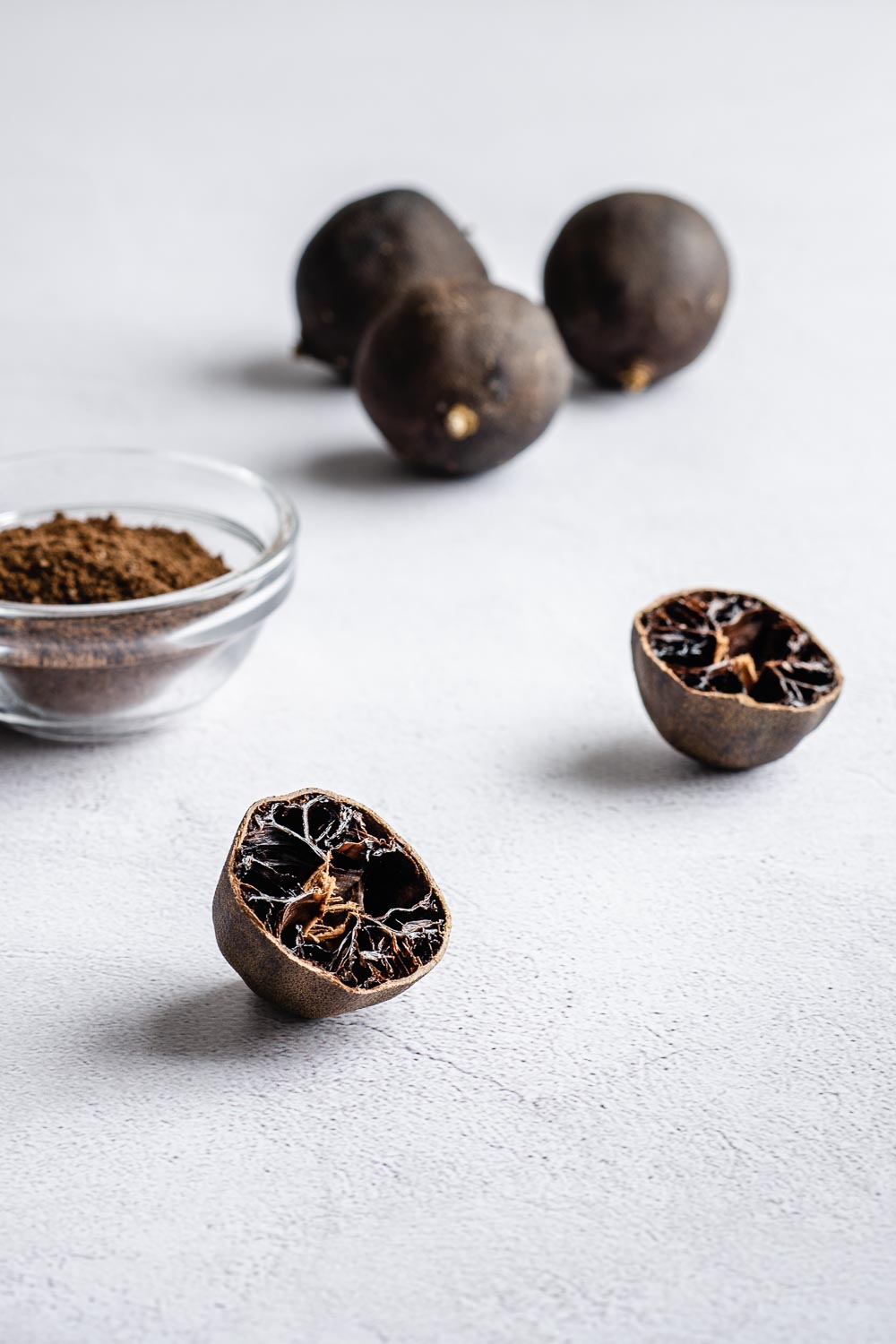
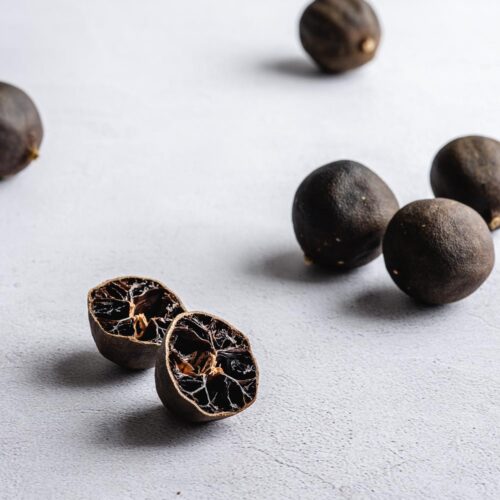
Equipment
- No special equipment is required to dry the limes. It can be dried in the sun if it is hot enough. You will need to rely on your oven's lowest setting in the cooler months. Though, if you do have a dehydrator, it should be able to get the job done in no time. A spice grinder or blender is handy if you want to make black lime powder.
Ingredients
- 10 fresh limes, preferably Persian limes or other thin-skinned seedless cultivars
- sea salt
Instructions
- Add water – enough to cover the limes – to a pot with 1 teaspoon sea salt per 1 litre of water. Bring the salted water to a rolling boil without the limes.
- While the water is heating up, get your ice bath ready by placing at least 10 blocks of ice and cool water in a container with enough space to hold the limes.
- Once the salted water in the pot reaches a boil, add the limes for 60 to 90 seconds.
- Remove the blanched limes with a slotted spoon and drop them into the ice bath to stop the cooking process. Leave the limes in the ice water until cool. Once ready, remove the limes and dry with a clean tea towel. Give shop-bought limes a good rub in case they still have some wax residue on them.
- To dry the limes, you can place them in direct sun during summer when it's properly hot outside. Alternatively, place the limes directly on your oven bars with the oven set to a low temperature, I use 70 °C (158 °F) in a non-fan oven. Use any temperature between 65 °C and 95 °C (150 °F – 200 °F) and dry until the limes are dark brown and hollow, or continue until almost black. It takes between 2 and 5 days depending on the method used.
- Once dried, store whole limes in an airtight container at room temperature. It will keep for several months. Or for ground black lime powder, bash the limes into a few pieces with a skillet. Remove any seeds and grind into a powder using a spice grinder, blender or mortar and pestle. Store it in a sealed container and sprinkle on everything!
Notes
- IMPORTANT: I always turn the oven off when unsupervised, i.e. when I leave the house or go to bed. Use your own judgement to determine what is safe in your environment.
- I use a combination of sun and oven drying, making use of any residual heat from dinner or the day’s baking. And I always turn the oven off before going to bed or leaving the house. This way it takes me roughly 3 days.
- Place the limes directly on the oven bars or a cooling rack when drying outside. This encourages air circulation. And remember to rotate the limes every now and then to ensure even drying.
- If you need to use your oven while it’s occupied by your limes, simply remove the limes and place them back in the oven once you are done baking and the oven has cooled down to a suitable temperature.
- If I know I’m going to grind my dried limes, I let them dry out until almost black and very light in weight. On the other hand, if I know they are going to be used whole very soon, I stop when they are brown so that they are easier to pierce. For longer storage, I always dry them out until very dark and hard.
- Soften a rock hard black lime in boiling water before piercing. Just remember to use that wonderful citrusy water in a stew or to boil rice.
Looking for black lime recipes?
Try these delicious recipes featuring black limes.
Or find my favourite cookbooks featuring black limes:
- Ottolenghi Flavour by Yotam Ottolenghi, Ixta Belfrage and Tara Wigley
- Ottolenghi Test Kitchen: Shelf Love by Noor Murad and Yotam Ottolenghi

Do you have a recipe to make black lime cordial? I had a gin cocktail the other day with black lime cordial and it was delicious!
Black lime cordial sounds AMAZING! I haven’t tried making it yet, but this is what I would do: Smash a few black limes into smaller pieces and place them in a saucepan. Add equal volume water and sugar. Bring to a boil and stir until the sugar dissolves. Then leave to infuse for 24 hours before straining.
Let me know if you try it. I might just give it a go myself for some holiday cocktails!
Thanks! I do have a follow up question. How does one know if they are sufficiently dried? Not having ever use the black line before, I don’t know what it should end up like.
Hi Jake,
Some people dry the limes until they are leathery, but I prefer to dry mine until rock hard. They are easier to grind into black lime powder this way, and I think it keeps mould at bay when you store them for a long time – I make a large batch when limes are in season and store them until the next year.
The lime should be dark brown, almost black and you should not be able the break or tear it by hand. Tap your black lime against a hard surface. It should make a hollow sound and should not dent at all.
If you’re still unsure, carefully slice a black lime in half – a serrated knife works best. The inside should have no fleshy bits left. There are a few images that show what the inside of a properly dried lime looks like when you scroll up in the post. (And don’t discard the sliced lime, you can already use it in recipes that require whole black limes or keep drying the halved lime with the rest of the whole ones.)
If I want to substitute the dried lime powder in a recipe that calls for 2 whole dried limes to be added to a broth that is simmering how much powder do you think I should add?
Hi Andrea,
When you add whole black limes to simmer in a stew, the flavour releases slowly, whereas the strong flavour of ground black lime imparts almost instantly. So, there is no need to simmer the black lime powder for hours. Luckily, this also makes it easy to adjust to taste.
I would start with 1 teaspoon of ground black lime towards the end of cooking, then have a taste. Add more black lime, half a teaspoon at a time, until the flavour is noticeable but not overwhelming.
Happy cooking!
just finished making mine and they’re perfect! I’d tried another method before with key limes, and I’m not sure if it was the method (they were just dried; no blanching in salt water first) or the limes themselves (key limes are FULL of tiny seeds), but that first batch came out unbearably bitter.
this time, using YOUR recipe and Persian seedless limes, they look perfect and the flavors are balanced! I’m so excited to use this; thank you!
Hi Diane,
Your comment made my day! I am thrilled that my post could help you with your first successful batch of black limes.
I have not tried to dry key limes yet, but I don’t think skipping the blanching process will cause the limes to be excessively bitter. So, it is probably the seeds (or maybe a thick pith) that caused the bitterness.
But I’m happy your Persian limes worked a treat. Happy cooking with your delicious black limes!
Amazing. Your recipe gives me a lot of ideas.
Thanks you!
I am so happy to hear that, Sal!
Good morning from Johannesburg! Made these yesterday because I also buy Yotam Ottolenghi’s books and get plain frustrated when I can’t get some of the ingredients. I used Woollies’ seedless limes, and they turned out beautifully. Thanks for such an easy recipe.
Yay! So happy you made them! And that you found the recipe easy to follow. I also love the Woolies seedless limes, they work great!
Thank you for taking the time to pop in, Debbie.
Happy Ottolenghi cooking with your black limes!
I tried this with Makrut limes and dried them overnight in a cooling wood-fired oven after cooking something else. It worked alright but the flavour is really strong!
Oh, interesting! I can imagine that Makrut limes would be quite intense, they’re so aromatic. If they are too intense to use whole, you can always make dried Makrut lime powder. Make sure they’re nice and dry, bash them with a heavy object to split them open, and remove any seeds. Then grind them in a spice grinder. Add it to flaked salt for Makrut lime salt.
Thank you!
I enjoyed reading what you have written. Great style. Thank you also for the important information the uninitiated may be unaware of, such as trying to pierce a hard lime.
Looking forward to ‘producing” the black limes. In Adelaide, South Australia, limes are not easy to find and expensive. I will, out of curiosity, see what happens when I use lemons.
Thanks again.
Ranjit Ratnaike
Hi Ranjit! Even in South Africa, limes can be expensive. So I buy lots when limes are in season and then preserve them as black limes that I can use throughout the year.
Please let me know how it goes with your lemons! I’ve made “black kumquats” but have not yet tried it with lemons. Try to find small lemons. Otherwise, it may take a very long time to dry out completely.
Thank you for popping in, Ranjit!
Adri
Amazing! The is the best recipe online. :)
Thank you so much, Paul! ❤️ They really are magical little flavour bombs.
Interesting!!!!!